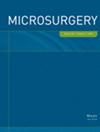In breast reconstruction with free flaps, retrograde venous anastomosis into the internal mammary vein (IMV) is often unavoidable. Utility of a crossing vein between the right and left IMV, one of the anatomical foundations which make retrograde flow possible, has been reported but only with a few detailed features. This study evaluated the presence, actual location, and diameter of the crossing veins using preoperative imaging such as contrast-enhanced computed tomography (CECT), or contrast-enhanced magnetic resonance imaging (CEMRI). Moreover, this is a preliminary non-invasive study to clarify these processes on a larger scale.
We included 29 cases of unilateral breast reconstruction performed between July 2018 and September 2023 at our institution using unipedicled or bipedicled free deep inferior epigastric artery perforator (DIEP) flaps with retrograde venous anastomosis to only one IMV at the level of anastomosis. No congestion or necrosis was observed. In the final 24 cases with sufficient imaging coverage of preoperative contrast-enhanced images (15 CECT and 9 CEMRI), the crossing veins of IMVs were detected and the number, localization, and diameter were measured.
In 20 cases of 24 images, the crossing veins between IMVs were completely identified (83%). In 18 of the cases, only one crossing vein was established immediately ventral to the xiphoid process, averaging 19.3 ± 7.18 mm caudal to the fibrous junction between the sternal body and xiphoid process. The average diameter of the veins was 1.57 ± 0.42 mm. In two other cases, the second crossing vein originated on the dorsal surface of the sternum, but it was a very thin vein of about 0.4 mm. Three images indicated incomplete identification of the crossing vein at the xiphoid process, and in one case, no crossing vein was observed between bilateral IMVs.
The contrast-enhanced imaging study revealed an anatomic feature that the crossing veins (about 1.5 mm in diameter) connecting the right and left IMVs are located just ventral to the xiphoid process. Furthermore, the crossing veins can be identified on contrast-enhanced images, and refinement of this method is expected to lead to future non-invasive anatomical investigations in an even larger number of cases.


